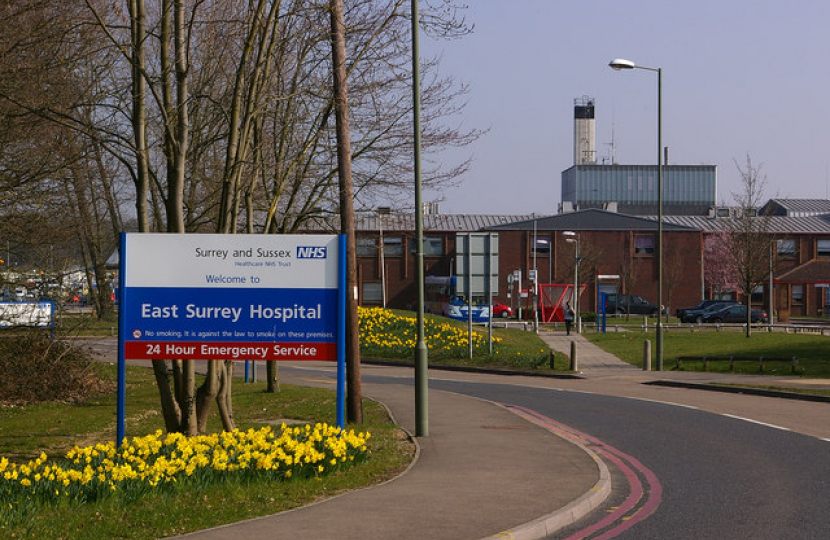
Press Release
Crispin Blunt MP has welcomed the announcement that East Surrey Hospital will get 64 new beds thanks to a government investment of £6 million.
Two new modular wards will be built to increase capacity by 32 beds and reprovide a further 32 beds.
Crispin Blunt said:
“That this Government continues to invest in health services, both locally and nationally, demonstrates that it is serious about cutting waiting times and improving health outcomes across the board.
Critics will say Conservatives do not care about the NHS. Our actions speak louder than words ever will: this move will result in 64 additional beds at East Surrey Hospital, boosting capacity in winter when it is needed most. It is a continuation of the significant investment in healthcare that began before the pandemic and only accelerated since - investment that continues to strike the right balance between ensuring excellent patient outcomes and careful administration of how money is spent. A win for local health services.”
Prime Minister Rishi Sunak said:
“Cutting waiting lists is one of my top five priorities, so this year the government has started planning for winter earlier than ever before and the public can be reassured we are backing the NHS with the resources it needs.
“These 900 new beds will mean more people can be treated quickly, speeding up flow through hospitals and reducing frustratingly long waits for treatment.”
Health and Social Care Secretary, Steve Barclay said:
“We know that winter is a difficult time so we’re working to get ahead of pressures whilst also creating a sustainable NHS fit for the future. That's why we're investing this £250 million to support NHS capacity and deliver 900 new beds, as part of our drive to put in place 5,000 permanent additional beds.
“Creating additional hospital capacity will support staff to provide the best possible care and treat patients more quickly, helping us to improve waiting times - one of the government’s top five priorities.”
Amanda Pritchard, NHS chief executive said:
“Winter is always a busy time for the NHS and so it is right that we put robust plans in place as early as possible to boost capacity and help frontline staff to prepare for additional pressure.
“Our winter plans, which build on the progress already made on our urgent and emergency care recovery plan, aim to reduce waiting times for patients and to transform services with an expansion of same day care and virtual wards, helping patients to be cared for in their own home where possible.”
Health Minister Will Quince said:
“Our Urgent and Emergency Care Recovery Plan, backed by record funding, has already improved A&E performance and ambulance response times and we want to go further by putting in place the right solutions so the NHS can better cope with challenges this winter.
“We will continue to work with integrated care systems to make sure the plan is delivering for patients this winter and beyond.”
This is part of a £250 million investment that will deliver 900 new hospital beds across England to help treat patients more quickly this winter. This funding has been awarded to NHS trusts to relieve pressures and help cut waiting times – one of the Government’s top five priorities.
30 NHS organisations across England will benefit from the investment to help ease pressure in urgent and emergency care services. This includes developing or expanding five urgent treatment centres and four same-day emergency care services which will help patients to be seen more quickly, without being admitted to hospital. The NHS expects that the majority of schemes will be completed by January to help deal with winter pressures.
This investment is part of the NHS Urgent and Emergency Care Recovery Plan, published in January, which set out plans to provide over 5,000 additional permanent, fully staffed hospital beds in total, with the NHS on track to deliver this by winter. These new 900 beds are part of this commitment.
These measures will support the NHS’s recovery from the pandemic, and ensure that patients receive the care they need, when they need it. Alongside this, the NHS Long-Term Workforce Plan will put the NHS on a sustainable footing by delivering the biggest training expansion in NHS history and recruiting and retaining hundreds of thousands more staff over the next 15 years.
Patients are already seeing improvements as a result of the Urgent and Emergency Care Recovery Plan, backed by record funding – with average Category 2 ambulance response times down by 27 minutes on July last year, and down by 60 minutes on the peak of winter pressures seen in December 2022.
The plan also includes a commitment for 800 new ambulances, including specialist mental health ambulances to improve ambulance response times this winter.
The schemes will also operate alongside new NHS centres that will identify and co-ordinate the best and quickest options for patients to be safely discharged from hospital when they’re ready – either at home or into social or community care.
The centres will bring together teams from across NHS, social care, housing, and voluntary services in one place to help make live decisions and offer patients everything they need in one place.
Earlier this month, the NHS announced its world-leading virtual ward programme would be expanding to children, with overall virtual wards bed numbers expected to hit 10,000 by autumn.
This capital funding is on top of the existing investment as part of the Urgent and Emergency Care recovery plan, with £1 billion of dedicated funding to support capacity in urgent and emergency services, building on the £500 million used last winter. The Government has also invested £200 million for ambulance services to increase the number of ambulance hours on the road, as well as a further £1.6 billion of funding for social care to reduce the numbers of beds occupied by patients ready to be discharged.
END
Notes to Editors:
Office of Crispin Blunt MP: 0207 219 2254 / crispinbluntmp@parliament.uk
